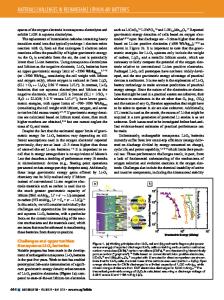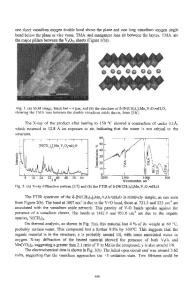The stabilization of layered Manganese Oxides for use in Rechargeable Lithium Batteries
- PDF / 710,874 Bytes
- 6 Pages / 417.6 x 639 pts Page_size
- 54 Downloads / 342 Views
Mat. Res. Soc. Symp. Proc. Vol. 575 ©2000 Materials Research Society
Manganese dioxides can cycle well as has been demonstrated for the two tunnel compounds, the hollandite H 4xMns-xO1 6 by Feng et al [12] and Li0 .4 4MnO 2 by Doeff [13, 14] and Armstrong [15]. This leads us to believe that if a layered manganese dioxide can be formed that resists reversion to spinel like structures on cycling, it will cycle well and have the capacity to be viable for the next generation lithium battery systems. Two approaches have been used to stabilize the layer structure of manganese dioxide. First pillars were inserted between the MnO 2 sheets to make the interlayer separation sufficiently large to be undesirable for manganese occupancy, and second, part of the manganese was substituted by other transition metals to make the MnO2 more LiCoO 2 -like. In the former case we placed emphasis on potassium ions as pillars where we had previously shown [6] that K.MnO 2 cycled better than NaxMnO 2, LixMnO 2, RbxMnO 2 and MgxMnO 2, and also on vanadium oxide groups because the latter might be electrochemically active. Another issue with manganese based cathodes is the high resistivity of the oxides particularly in the +3 oxidation state. We have thus made a study [ 16] of the effect of doping the preferred oxide, KxMnO 2 as well as NaxMnO 2 , with other transition metals such as Co, Fe and Ni. These materials have been made both at elevated temperatures (700-800'C) as well as under hydrothermal conditions. We report here the results on the hydrothermally prepared compounds of KxMni-yCoyO 2. EXPERIMENTAL (Na,K)xMn1-yCoyO 2 materials for 0
Data Loading...











